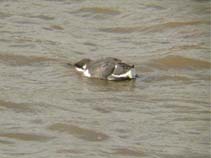Alca torda Linnaeus, 1758
Razorbill
Classification / Names Κοινά ονόματα | Συνώνυμα | CoL | ITIS | WoRMS
Aves | Charadriiformes | Alcidae
Environment: milieu / climate zone / εύρος βάθους / distribution range Οικολογία
; εύρος βάθους 0 - 120 m (Αναφ. 62202). Polar; 82°N - 27°N, 80°W - 43°E (Αναφ. 124582)
Distribution Χώρες | Περιοχές FAO | Οικοσυστήματα | Παρουσίες | Εισαγωγές
Northwest Atlantic, Eastern Atlantic and the Arctic: Polar to temperate.
Length at first maturity / Μέγεθος / Weight / Age
Γεννητική Ωρίμανση: Lm ? range ? - ? cm Max length : 45.0 cm TL αρσενικό/απροσδιόριστο; (Αναφ. 8812); μεγ. δημοσιευμένο βάρος: 719.00 g (Αναφ. 356)
Short description Μορφολογία
Life cycle and mating behavior Γεννητική Ωρίμανση | Αναπαραγωγή | Γεννοβολία | Eggs | Γονιμότητα | Larvae
Main reference
Αναφορές | Συντονιστής | Συνεργάτες
Camphuysen, C.J.K. 1998 Razorbills Alca torda in Dutch waters. Limosa 71(2):69-77. (Αναφ. 7319)
IUCN Red List Status
(Αναφ. 130435: Version 2025-1)
CITES status (Αναφ. 108899)
CMS (Αναφ. 116361)
Threat to humans
Human uses
| FishSource |
Εργαλεία
Περισσότερες πληροφορίες
Διαδικτυακές πηγές
BHL | BOLD Systems | CISTI | DiscoverLife | FAO(Publication : search) | Fishipedia | GenBank (genome, nucleotide) | GloBI | Gomexsi | Google Books | Google Scholar | Google | PubMed | Δέντρο Ζωής | Wikipedia (Go, αναζήτηση) | Zoological Record



